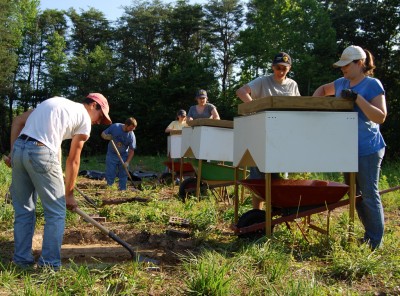
Students and alumni from St. Mary's College of Maryland excavate test units at the Zekiah Fort site: left to right: Alex Flick, Scott Strickland, Skylar Bauer, Margaret Lucio, Stephen Gladu, Patricia Byers. (Photo: SMCM)
ST. MARY’S CITY, Md. (Sept. 20, 2011)—Archaeologists from St. Mary’s College of Maryland, in partnership with the College of Southern Maryland and local businessman Michael Sullivan, have discovered a 17th-century Piscataway Indian fort just outside of Waldorf, Maryland. For years, historians and archaeologists have searched for evidence of what is known as the Zekiah Fort, where the Piscataway moved in 1680 for protection from raids by northern Indian groups and English encroachment on their land.
Details of the significant discovery were revealed at a press conference Thursday, Sept. 15, in Mount Victoria, Maryland, attended by Gov. Martin O’Malley, Sen. Mike Miller, Sen. Thomas "Mac" Middleton, both college presidents, and other state and local officials, numerous historic and preservation organizations, and representatives of the three local Indian tribes.
“As Marylanders, we know it is important that we celebrate our history and our rich diversity,” said O’Malley. “I congratulate Michael Sullivan, St. Mary’s College of Maryland, and the Piscataway Tribal communities on the discovery of this 17th-century Piscataway Indian fort. You’ve helped accomplish what researchers have been trying to do for eight decades – helping us better understand a culture that traces back eight centuries.”
“The Zekiah Fort search,” added St. Mary’s College President Joseph Urgo, “ provided our students and alumni with another opportunity to engage in a research opportunity beyond the boundaries of the classroom," he said. "This venture has served to strengthen ties between our college and the Southern Maryland community where it resides. It is an honor to participate in this landmark announcement and to learn about the Piscataway's ancestral legacy and how it contributes to the legacy and history of our great state."
It was not until 2009 that Sullivan, along with St. Mary’s students under the direction of anthropology professor Julia King and in consultation with members of the Piscataway Indian community, began a systematic search for the fort and its surrounding settlement. Sullivan, who was working on a history of Charles County to help celebrate its 350th anniversary, tracked records and deeds back to the 1600s; he approached King with an idea of where the site might be. The team picked up the search and examined 300-year-old land records and old patents.
This spring and summer, two St. Mary’s alumni, Scott Strickland and Alex Flick, as well as students from King’s anthropology classes, focused on an undisturbed parcel of land. Very quickly, they found gun flints made of both European and local stone, and lead shot where they believe the fort stood; and glass beads, Indian and European pottery and tobacco pipes where the hamlets were.
“This was an intensively occupied settlement,” said King. “At least 90 and perhaps as many as 300 people lived around the fort.”
In 1680, the Piscataway, including the Cedarville Band of Piscataway Indians, the Piscataway-Conoy Tribe of Maryland, and the Piscataway Indian Nation, were the focus of raids by northern Indian groups, including the Seneca and their allies, and by hostile English settlers who wanted their rich agricultural land. For their protection, Charles Calvert, the third Lord Baltimore, moved them onto the Zekiah Manor where they built a fort and surrounded it with small hamlets. When trouble brewed, they would run to the fort. A large spring was nearby as was the trail that became Route 5. The Indian families stayed there for about 12 years, until 1692, when they moved to what is now Prince George’s County and Virginia.
“Although Piscataway history is foundational to Maryland history, we so rarely hear about it, in part because surviving records are thin and somewhat biased, having been written by colonial administrators,” King said. “Finding the Zekiah Fort presents us with a very different kind of record about Piscataway life. The artifacts we are finding reveal a vibrant culture that shows how, under some unimaginable pressures, the Piscataway nation maintained their lifeways even as they adjusted to the European culture.
“The students are as responsible for this discovery as anyone,” King added. “They not only excavated the test pits, they were intimately involved in tracing titles, mapping 17th-century property lines onto modern maps, and met often to help build the model for where the fort may be located.”
The general area where the fortified settlement was found has been intensively developed and gravel-mined in the last half-century, so researchers are delighted the fort survives.
"The Piscataway Conoy people are indeed grateful for the efforts shown by the students in forging ahead in locating our old fort,” said Mervin Savoy, tribal chairwoman of the Piscataway-Conoy Tribe. “This will have a positive impact on not just our youth but on all residents of the state.”
Rico Newman, spokesman for the Piscataway-Conoy Tribe, agreed. “Locating the Piscataway Fort site and other recent discoveries significant to its Indigenous peoples represent opportunities for research and scholarship for archaeologists, anthropologists, and historians. For the successors of interest to these discoveries, their descendants, it represents opportunities for recovery, historical and cultural."
Source: SMCM


